Kathleen Flinn's Blog, page 25
September 5, 2012
Auditions for Kitchen Circus
 Kitchen confident home cooks, heads up!
Kitchen confident home cooks, heads up!
Kitchen Circus is holding open auditions for amateur home chefs. Audition information at http://kitchen-circus.com and submissions are due September 21, 2012.
Kitchen Circus is hosted by my pal, Thierry Rautureau, the French chef featured in The Kitchen Counter Cooking School. It’s a live cooking competition where home cooks will prepare one course of a three course meal for 45 guests at Rover’s restaurant in Seattle. What makes this competition exciting is you can be involved in all aspects; amateur home cooks can audition to compete, the dishes will be judged by all the dinner guests, and videos will be free for our online fans. One home cook winner will be chosen at the end of each dinner, and the winners from the first three episodes will move on to the finale at the end of the season.
Nominate a friend to audition, and if they make it, you may win 2 tickets to a Kitchen Circus dinner, enter on Facebook.com/KitchenCircus


August 31, 2012
Friday Reads: Our Rescue Dog Edition
 If Mike ever thought he wanted a threesome with a young blonde, I don’t think this is what he had in mind.
If Mike ever thought he wanted a threesome with a young blonde, I don’t think this is what he had in mind.
About a month ago, Mike and I adopted an 18-month-old rescue dog we named Maddy who had been picked up by animal control in Yakima. Although the rescue organization thought she might be a Cairn terrier mix, we suspect she’s actually a Dutch Smoushound, a rare terrier breed that was brought back from extinction by a woman named Mrs. Barkman. (I’m not making that up.) Maddy had been adopted twice and returned to the rescue organization. The first adoptive family, an elderly couple, returned her in part because she didn’t “speak English.” The second, a doctor and his wife, decided after two weeks they didn’t have time for a dog after all.
She’s a sweet, loving little girl who was pretty terrified of people and traffic at first, but she’s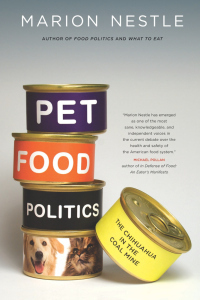 getting more brave everyday. Mike and I have been trying to study and learn all we can about being good dog parents. Of course, since I’m a reporter at heart, I have checked out most of the books on dogs from the Seattle Library. Here are the best ones that I’ve read in the past couple of weeks.
getting more brave everyday. Mike and I have been trying to study and learn all we can about being good dog parents. Of course, since I’m a reporter at heart, I have checked out most of the books on dogs from the Seattle Library. Here are the best ones that I’ve read in the past couple of weeks.
 We got a lot of general books on dogs, but The Dog Bible by Kristin Mehus-Roe was probably the most useful for understanding fundamentals of how to take care of a dog, variations on training styles and so on. Marion Nestle’s Pet Food Politics: The Chihuahua in the Coal Mine pretty much freaked me out about commercial dog food.
We got a lot of general books on dogs, but The Dog Bible by Kristin Mehus-Roe was probably the most useful for understanding fundamentals of how to take care of a dog, variations on training styles and so on. Marion Nestle’s Pet Food Politics: The Chihuahua in the Coal Mine pretty much freaked me out about commercial dog food.  That led me to the book Feed Your Best Friend Better by Rick Woodford aka The Dog Food Dude, provides a very helpful look at what foods you can safely feed your dog and how to supplement commercial dog food. He has some interesting tips, too, such as making sure your dog gets enough calcium by pulverizing eggshells into a fine dust and adding a tiny amount to their food.
That led me to the book Feed Your Best Friend Better by Rick Woodford aka The Dog Food Dude, provides a very helpful look at what foods you can safely feed your dog and how to supplement commercial dog food. He has some interesting tips, too, such as making sure your dog gets enough calcium by pulverizing eggshells into a fine dust and adding a tiny amount to their food. Good Dog, Bad Habits by Jeanne Carlson has been helpful in assisting us to understand why Maddy does certain behaviors. We’re much more aware of her body language and what it means. Finally, we picked up a copy of Best Hikes with Dogs in Western Washington by The Mountaineers.
Good Dog, Bad Habits by Jeanne Carlson has been helpful in assisting us to understand why Maddy does certain behaviors. We’re much more aware of her body language and what it means. Finally, we picked up a copy of Best Hikes with Dogs in Western Washington by The Mountaineers.
I’ll never totally understand what Maddy thinks or what she’ll do. We have a lot more to learn. But one thing I can say, when Maddy comes to bed with us at night, we both tell her that’s she a beautiful little blonde.


August 30, 2012
In Seattle? Come to a knife sharpening party for the paperback launch Sept. 25th or 26th
Normally, I try to avoid inviting dull party guests. But we’re having a party and your knives are invited, especially the dull ones.
 The paperback of The Kitchen Counter Cooking School goes on sale Tuesday, September 25th. To mark this extraordinary occasion, I’ll be doing two events in greater Seattle. The first will be at the fabulous culinary book store, The Book Larder, on the day it goes on sale. It’s going to be a super fun event, with stations set up around the store for comparative tastings of everyday cooking staples, a sampling of recipes and some lovely wine. But, there’s more! Also on hand will be my pal Bill Magee, who will be bringing his mobile knife sharpening operation, Cutlery on Wheels. You’ll get a chance to try out a variety of knife styles and brands – and, if you bring your knives, he’ll be able to either sharpen on site or arrange to drop them off at your home or work. Everyone will get some fun swag, plus we’ll have some prizes, including a $20 gift certificate for knife sharpening. Cost is $20 and includes a signed copy of the paperback.
The paperback of The Kitchen Counter Cooking School goes on sale Tuesday, September 25th. To mark this extraordinary occasion, I’ll be doing two events in greater Seattle. The first will be at the fabulous culinary book store, The Book Larder, on the day it goes on sale. It’s going to be a super fun event, with stations set up around the store for comparative tastings of everyday cooking staples, a sampling of recipes and some lovely wine. But, there’s more! Also on hand will be my pal Bill Magee, who will be bringing his mobile knife sharpening operation, Cutlery on Wheels. You’ll get a chance to try out a variety of knife styles and brands – and, if you bring your knives, he’ll be able to either sharpen on site or arrange to drop them off at your home or work. Everyone will get some fun swag, plus we’ll have some prizes, including a $20 gift certificate for knife sharpening. Cost is $20 and includes a signed copy of the paperback.
Can’t make that one? Fear not. The fun shifts to Third Place Books in Bothell on Wednesday, Sept. 26th. We’ll do the comparative tastings, I’ll talk about the project and Bill will be on hand with his truck for sharpening there, too. That event is free. RSVP ahead of time for a special gift.
Cutlery on Wheels charges about five or six bucks a knife; make sure you protect the blade for travel for reasons that should be obvious.


August 24, 2012
Friday Reads: How to Cook Everything plus win tickets to Mark Bittman in Seattle
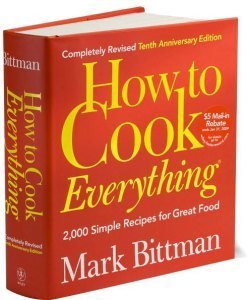 Here’s the trouble with artichokes.
Here’s the trouble with artichokes.
No one knows what to do with them. Eggplants suffer a similar dilemma.
When I’ve interviewed home cooks about why they end up relying on processed foods, it’s not necessarily because they are short of time or lured in the theory of convenience. More often than not, lack of knowledge of what do with something such as an artichoke or an eggplant or a whole chicken undermines their confidence in the kitchen. The path of least resistance leads them to a frozen dinner instead.
What I like about Bittman’s “How to Cook Everything” is that it’s a true reference guide. The content spans from the most simple tasks, such as how to core an apple or measure flour, to more ambitious efforts, such as preparing a rack of lamb or make mayonnaise.
I’m a read-cookbooks-in-bed type, but must admit I’ve got the app for this one, too. It’s more interactive and searchable and a decided value even at $9.99 for the iPad versions since you get all of the contents of the book, as this review from CNet notes.
All of this is leading up to one of the few giveaways I’ve done on my site.
Bittman will be in Seattle next month for the Seattle Arts & Lecture series on September 19th. His talk will be on “The Future of Food,” and the intersection of food, politics, the environment, and personal health. He’ll discuss “non-foods”, like soda, and their impact, as well as how policy pushes foods such as wheat, meat, and dairy, that may be in no one’s best interests.
Anyone who knows me will understand why I’m keen to promote such an event.
To help spread the word, I’ve got two tickets to give away. To enter to win, simply send me an email. Note if you’ll be in Seattle on Sept. 19th. If not, then you win the outside-Seattle prize — a copy of How to Cook Everything. I’ll draw a winner at random a6 5 p.m. Pacific time on September 4th. Please note, entry will enroll you in my newsletter if you’re not already on the list; you can always unsubscribe.


August 23, 2012
Big News! My third book debuts in 2014
“I don’t have to tell you I love you. I fed you pancakes.”
–
my grandmother, Inez Monk Henderson
It’s official. I’ve sold my third book! Viking/Penguin, publisher of my first two books, has purchased my next one. The working title is Burnt Toast Makes You Sing Good: Culinary adventures from a Midwest childhood. The anticipated publication date is Winter/Summer 2014. My agent pitched it as The Glass Castle meets Ruth Reichl meets David Sedaris, except we were less poor than Jeannette Walls, and I’m not nearly as funny as David Sedaris. Also, we were Baptists, not Jewish. Otherwise, it’s just like that.
I’ve been working on this project on and off for a couple of years, digging into the collective memories of my family, rifling through old recipes and photographs of scenes such as my sister wearing her baton tiara while showing off a mess of freshly caught fish set out on a wet newspaper.
Burnt Toast Makes You Sing Good is a memoir with recipes that tells the story of my culinary lineage, but also provides insight into the values, morals and attitudes of food that span three generations. Food writing does an often unappreciated job of articulating so much about shifting culture, and the timeline focused on this book – from 1955 to 1981 – represents a watershed of change in how America viewed food and eating, and how what we think we want can come full circle.
The book starts with my parents, both Michigan natives and the unlikely proprietors of an Italian restaurant in San Francisco. No matter they were the offspring of Irish and Swedish immigrants at a time when Italian was still considered “ethnic,” they packed up their three kids, my mother heavily pregnant with a fourth and headed west, a crib and a rocking chair in a trailer tacked to the back of their station wagon. “It was a great adventure,” mom said. “Until, of course, the whole thing went bust.”
After San Francisco, they dragged the kids back across the country to a dilapidated farmhouse in the curious world of semi-rural Michigan on 10 acres where we lived in poverty for more than a decade. We raised chickens, tended a large organic garden and canned all the results for winter – all those homespun pursuits so much in vogue these days among domestic DIYers. My family did it because once the snow fell, you had to buy your food, and we couldn’t afford that. Of course, that made me long for Wonder Bread, HoHo’s and canned soup. Once our fortunes improved, we moved into the town of Davison, just down the street from a young Michael Moore. Once I had the money to buy Wonder Bread and Ho Hos, all I wanted was homemade bread and my mother’s chicken soup.
In reality, it starts earlier than the 1950s, heading all the way back to 1883 when my 14-year-old great-grandmother Anna arrived from Sweden with her brother and worked for a decade as a cook in middle class Minneapolis households in order to bring the rest of their family to America. My other great-grandparents hailed from Wales and Ireland and worked against the odds to make a life for themselves in American and passed on the recipes they knew from home. Over time, they shifted and bent their recipes to the will of American cuisine.
Hey, but I shouldn’t even be talking about this. I’m going to be resurrecting my recipe testing group once again to test recipes for the upcoming book, and I’ll be hosting a series of “work in progress” readings at the Richard Hugo House in Seattle November through May. I’ll be hosting at least one live online.
Thanks to everyone for their support. It means so much to me. So often, writing feels like a process that takes place in a vacuum.
Now, on to writing the darn thing.


August 22, 2012
Paperback Tour Dates Announced!
 The paperback version of The Kitchen Counter Cooking School hits the shelves on September 25th. Here’s the new cover, with the same content, only cheaper! Actually, there’s more content as the paperback has a cool Book Club and Reader’s Guide with suggestions to do crazy things such as raid the hostess’s fridge.
The paperback version of The Kitchen Counter Cooking School hits the shelves on September 25th. Here’s the new cover, with the same content, only cheaper! Actually, there’s more content as the paperback has a cool Book Club and Reader’s Guide with suggestions to do crazy things such as raid the hostess’s fridge.
To promote this momentous milestone, I’ll be on tour in October and November throughout the United States. The book launch party will be at The Book Larder in Fremont. After Seattle, I’ll head to Atlanta (Oct. 7th), Washington, D.C. (Oct. 9th), Miami (Oct. 11th), Portland (Oct. 1-4th),Tampa Bay area (Oct. 23-26th), Austin, Texas (Nov. 8th or 9th) and Houston (Nov. 10th and 11th).
Most of the events will include tastings of everyday kitchen staples, such as salts, tuna fish, olive oil and there will be at least one giveaway of swag at each stop, plus each person who buys a book will get a little thank you gift from me. You can see the curren list of events here.
Also, the private in-home cooking lessons/book parties are back by popular demand! We have opportunities in six areas for a one-of-a-kind experience. I’ll show up, host a private cooking lesson in your kitchen (or whatever room can hold your guests) and help you organize a comparative tastings of everyday kitchen staples (such as salt, olive oil, chicken stock, etc.) You invite your friends, book club members, neighbors and so on to buy some books. (That’s the point of the tour, after all.) As the host or hostess, you’ll get some pretty great swag plus signed first edition copies of both books and your fabulous shindig promoted across the social media universe. If you’ve got a blog or a book yourself, I’ll help you cross-promote it.
The locations and dates for 2012: greater Seattle (Sept. 28th or 29th), Atlanta (Oct. 7th), Washington, D.C. (Oct. 9th), Miami (Oct. 11th), Portland (Oct. 1-4th),Tampa Bay area (Oct. 23-26th), Austin, Texas (Nov. 8th or 9th) and Houston(Nov. 10th or 11th). Drop an email if you’re interested, or if you’ve got an idea of another event, media coverage or whatever.


August 15, 2012
Happy 100th Birthday, Julia!
Mike and I shot this video of Jacques Pepin talking about Julia in his kitchen last October. As I looked at this morning, I thought, “Wow, this is a long way from covering cops in Florida.”
In 1995, I was a reporter at the Sarasota Herald-Tribune. I’d moved up to a beat gig after spending more than a year on the obit desk. At some point, after covering endless series of school board meetings, press conferences and reporting stupid, horrible crimes committed by stupid, horrible people, I started to wonder. Was this journalism thing really for me? What did I really want to write about for the rest of my life? Was it murder and politics, or perhaps something else?
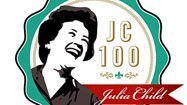 My mother, the smartest woman I know, advised that answer was right in front of me. Literally. We were chatting in the cheap but cheerful apartment I rented on the edge of a half-decent neighborhood in Bradenton, Fla. I’d erected an enormous wall of shelves with concrete blocks and lumber loaded with cookbooks, food history books, and fading copies of Gourmet. “I would think you’d want to write about what you like to read, but what do I know?” she said. Of course, she knows everything. But how to set out to be a food writer?
My mother, the smartest woman I know, advised that answer was right in front of me. Literally. We were chatting in the cheap but cheerful apartment I rented on the edge of a half-decent neighborhood in Bradenton, Fla. I’d erected an enormous wall of shelves with concrete blocks and lumber loaded with cookbooks, food history books, and fading copies of Gourmet. “I would think you’d want to write about what you like to read, but what do I know?” she said. Of course, she knows everything. But how to set out to be a food writer?
I went to a bookstore and bought a copy of Shaw’s Guide to Cooking Schools. Inside its red jacket, I read about the most extraordinary thing ever: a food writing symposium held at The Greenbrier, a posh West Virginia spa. Back in that day, I had to actually call to ask them to send me a list of the speakers via postal mail. The packet arrived and it was thrilling. The biggest news? Julia Child would be there.
I was born in the late 1960s on a farm in Michigan. Between my parents strict rules on viewing and our inability to get any real channels like NBC, we were stuck mostly watching PBS. By the time I became conscious of the world around me, Julia was in it. I grew up watching her talk about chickens and rescuing Hollandaise. My life changed directions repeatedly as a kid. I went from a big family on a farm to a comfortable suburban home that felt like a raft on which my brothers and sister kept evacuating. My dad was diagnosed with cancer when I was eight. Three year later, I moved to Florida, where we’d had a second home. Not long afterward, he died.
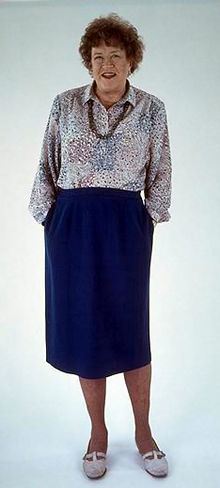 The only constant in this scenario? Julia Child.
The only constant in this scenario? Julia Child.
I started to watch her when I was three-years-old. She was who I turned to when I was eight and started to cook for myself in the afternoons when I came home to an empty house. I brought Mastering the Art of French Cooking to scho0l as a show-and-tell the same year, prompting one girl to call me a “weirdo.” (She would not be the last.) I threw my first dinner party cooking from that book for my high school friends at age 16. When I moved away to college in Chicago, I’d watch her, homesick for my family.
At The Greenbrier, I’d get a chance to meet her! In person! So, I ate beans and rice for nearly two months to save the money to go. I saw Julia the first night, but didn’t have the guts to talk to her. The next morning, I went into the first session a few minutes later. I quietly, breathlessly collapsed into a chair. A couple of minutes later, the side door opened and I heard a familiar voice ask, “Is this seat taken?”
It was Julia Child.
I stammered no, and she dropped her impressive physical self next to me. “That salmon at breakfast was so good, I had to stay and finish it,” she whispered conspiratorially.
She took copious notes of the morning’s session. She asked questions and made jokes. When the subject of getting kids interested in cooking came up, a male attendee with a regional cooking show told the group, ”Sometimes, I use a 12-year-old kid on my show.”
Julia’s hand went up. Without missing a beat, she deadpanned: “Really? How do you cook him?”
As we broke for lunch, she closed her notebook with a satisfied smile. “I always love to come to this workshop. You learn so much,” Julia said. This amazed me. After all, she was Julia freakin’ Child. I assumed she knew everything there was to know about food and cooking. I politely told her so.
She laughed. “Oh no, you can never know everything about anything, especially something you love,” she said, patting me on the knee. “Besides, I started late.”
At an evening reception, I told her the story about the short obituary and the ad for Le Cordon Bleu at my desk and my plan one day to attend her alma mater. She assured me that going to Le Cordon Bleu was the best thing she ever did in her life.
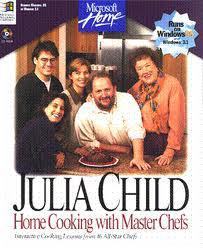 Our paths crossed again a couple of years later while I was working for Microsoft. Another group on my campus was holding a party to celebrate the release a CD-ROM featuring Julia Child, and I wrangled an invite. I had no idea that Julia would be at the party, so I was taken aback when once again, I ended up sitting right next to her. I reminded her we’d met at The Greenbrier and she nodded. She remembered our conversation. “So did you go to Le Cordon Bleu?” she asked. I didn’t have an answer, and we changed the conversation. She was curious about technology and wanted to know what I was doing. I explained I was the food and restaurants editor for Sidewalk.com, which she found intriguing. Then, she wanted me to explain why her AOL internet connection was so slow.
Our paths crossed again a couple of years later while I was working for Microsoft. Another group on my campus was holding a party to celebrate the release a CD-ROM featuring Julia Child, and I wrangled an invite. I had no idea that Julia would be at the party, so I was taken aback when once again, I ended up sitting right next to her. I reminded her we’d met at The Greenbrier and she nodded. She remembered our conversation. “So did you go to Le Cordon Bleu?” she asked. I didn’t have an answer, and we changed the conversation. She was curious about technology and wanted to know what I was doing. I explained I was the food and restaurants editor for Sidewalk.com, which she found intriguing. Then, she wanted me to explain why her AOL internet connection was so slow.
Julia Child died in 2004, when I was in the middle of my culinary training at Le Cordon Bleu in Paris. I never got to truly thank her for all the inspiration she gave me, and still gives me today. I think Julia Child’s popularity endures because did what we all want to do with our lives: she lived it passionately and generously, on her own terms with great conviction. If that’s not success, then I don’t know what qualifies. So, happy birthday, Julia. And thank you for everything.
ALSO:
Check out my review of the Julia Child app, released as a tie-in with her birthday.
I’ll be talking about Julia and serving up some confite de tomate provenca l at the University Bookstore tonight in Seattle.
As part of my gig as a board member for the International Association of Culinary Professionals, I worked with the Julia Child Foundation to develop a special one-time writing, food styling and photography award based on Julia; if you’re a member of the IACP, take a look. (Entry is free, but you have to be an IACP member to participate.)


August 14, 2012
Recipe: A Tomato Dish for Julia Child
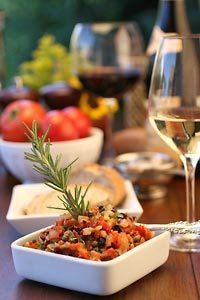 In honor of Julia Child’s 100th birthday, I’m making this delicious tomato dish tomorrow for a potluck event at the University Bookstore here in Seattle. Not only is it a great way to use up any extra tomatoes this summer, plus it’s also a crowd pleaser. People have purchased my first book based on tasting this recipe alone. Come join in the fun, try my dish and help toast my hero’s legacy.
In honor of Julia Child’s 100th birthday, I’m making this delicious tomato dish tomorrow for a potluck event at the University Bookstore here in Seattle. Not only is it a great way to use up any extra tomatoes this summer, plus it’s also a crowd pleaser. People have purchased my first book based on tasting this recipe alone. Come join in the fun, try my dish and help toast my hero’s legacy.
Confit Provençal aux Tomates
Provençal tomato spread
This spread uses quintessential ingredients from the south of France. This is great served on its own with crackers or bread. I also use it to accompany seared or grilled tuna. If you can’t find nicoise olives, substitute another rich, black olive such as kalamata. Makes about 2 ½ to 3 cups.
4 tablespoons olive oil
1 red medium bell pepper, peeled, finely chopped
1 large onion, finely chopped (about 1 ½ cups)
3 to 4 cloves of garlic, finely chopped
2 tomatoes, peeled, seeded and chopped (about 1 cup)
6 to 8 sun-dried tomatoes, chopped (¾ cup)
12 Nicoise olives, chopped
3/4 tablespoon capers
2 cups chopped fresh basil
In a small sauté pan, warm the oil over medium heat. Add bell pepper, onions, and garlic and cook until soft. Add the chopped tomatoes, sun-dried tomatoes, olives and capers and cook gently. Remove from heat. When cool, add the basil. Add coarse salt and pepper to taste.


August 7, 2012
How to do a Tasting and Why You Should
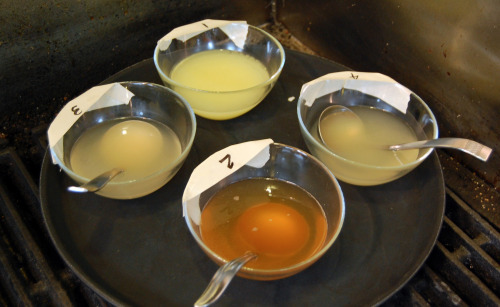 So Bon Appetit has announced that its going to do start doing it own “seal of approval,” putting its stamp on products the magazine’s team of editors and recipe testers like and recommend. I’m fine with this as a way to get more exposure for good products, but here’s what I recommend: get some friends over and find out what you like when it comes to cooking staples.
So Bon Appetit has announced that its going to do start doing it own “seal of approval,” putting its stamp on products the magazine’s team of editors and recipe testers like and recommend. I’m fine with this as a way to get more exposure for good products, but here’s what I recommend: get some friends over and find out what you like when it comes to cooking staples.
Think of it as a wine tasting, but instead, assemble a mix of various brands or versions of one or more everyday grocery staples, such as salt, pasta, cheese, olive oil, chicken stock (above), vinegar, fresh or canned vegetables, such as tomatoes, beans, etc., peanut butter and canned tuna. I’ve even done comparative tastings with frozen peas. For instance, with parmesan cheese, you’d want to try out an array of price ranges and styles, from freshly grated authentic Parmigiano-Reggiano, to a pre-shredded supermarket to the dried, grated stuff in a can. Remove a portion from the packaging and taste each item blindly, take notes and compare. You can use small dishes, small paper plates, whatever, just make sure you mark them with a number or letter and keep track.
Online inspirations:
SaltySeattle.com’s awesome salt-tasting party
Nami-Nami’s fresh tomato tastings
Fresh apple tasting tips from U.S. Apples
Peanut butter tasting at 5DollarDinners
This is a fun experiment to do with friends and neighbors. Just ask each to bring what they’ve already got in their cupboards or fridges, or assign them something to bring. It’s a great conversation starter, and an excellent addition to a book club.
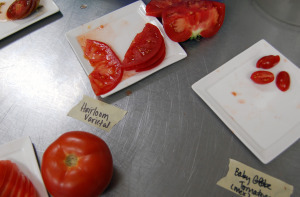 After having done this with numerous people over the past few years, here’s a few tips. Try at least three to five samples of each food products, but no more than that or it will overwhelm most people’s palates. Most people don’t have the vocabulary to articulate what they’re tasting, so I recommend It’s helpful to provide a list of descriptive words to get people thinking about what they’re tasting, such as this list of wine terms (most can be applied to food), and this list of food-related words.
After having done this with numerous people over the past few years, here’s a few tips. Try at least three to five samples of each food products, but no more than that or it will overwhelm most people’s palates. Most people don’t have the vocabulary to articulate what they’re tasting, so I recommend It’s helpful to provide a list of descriptive words to get people thinking about what they’re tasting, such as this list of wine terms (most can be applied to food), and this list of food-related words.
What’s important isn’t what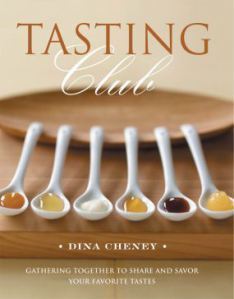 the others think, but starting to understand what you like and seeing how what you purchase and start cooking with affects the final outcome of the dish. As the French chefs taught me at Le Cordon Bleu, it’s important to taste, taste, taste as you cook — taste the ingredients you’re using before you add them, tastes multiple times as you cook a dish and taste it again before you serve it.
the others think, but starting to understand what you like and seeing how what you purchase and start cooking with affects the final outcome of the dish. As the French chefs taught me at Le Cordon Bleu, it’s important to taste, taste, taste as you cook — taste the ingredients you’re using before you add them, tastes multiple times as you cook a dish and taste it again before you serve it.
Recommended reading: I’m a fan of the book The Tasting Club by Dina Cheney, which provides more insight into how to conduct tastings of all kinds of ingredients, including chocolate and olives. Her book gave me the idea to start doing tastings in the first place, and I still refer to it. If you’re interested in tastings, it’s certainly worth a look.


August 3, 2012
Friday Reads: Old School to Street Food
These two books may seem to have nothing in common, but in the end, they’re both by guys who truly appreciate great food.
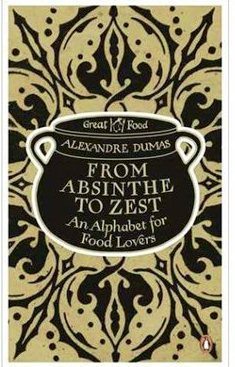 I’ve finally started the Great Food series from Penguin (my publisher). I’m not sure why I’ve put them off since they’re all short reads with gorgeous cover art. I started with From Absinthe to Zest by Alexandre Dumas. Yes, that Alexandre Dumas, the one who wrote The Three Muskateers and The Count of Monte Cristo. A prolific writer, Dumas was also well-known as a gourmand whose cosmopolitan outlook is evident in The Great Dictionary of Cuisine, first published posthumously in 1873. Dumas wrote that it was “to be read by the sophisticated and used by the practitioners of the art.” It’s great stuff, with rhapsodies on humble anchovies to the art of the omelet.
I’ve finally started the Great Food series from Penguin (my publisher). I’m not sure why I’ve put them off since they’re all short reads with gorgeous cover art. I started with From Absinthe to Zest by Alexandre Dumas. Yes, that Alexandre Dumas, the one who wrote The Three Muskateers and The Count of Monte Cristo. A prolific writer, Dumas was also well-known as a gourmand whose cosmopolitan outlook is evident in The Great Dictionary of Cuisine, first published posthumously in 1873. Dumas wrote that it was “to be read by the sophisticated and used by the practitioners of the art.” It’s great stuff, with rhapsodies on humble anchovies to the art of the omelet.
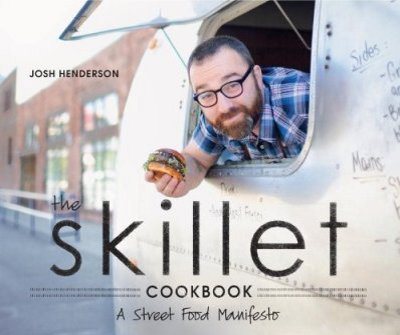 When I opened my mail a week ago and found Sasquatch Publishing had sent me a copy of Skillet: A Street Food Manifesto by Josh Henderson, I literally jumped up and down.
When I opened my mail a week ago and found Sasquatch Publishing had sent me a copy of Skillet: A Street Food Manifesto by Josh Henderson, I literally jumped up and down.
I’m a huge fan of Skillet. I once waited (happily) in a rare Seattle downpour for their big, soft biscuits with sage gravy, so imagine my gratitude to find the recipe included in the book. Other Skillet notables include their classic burgers and folded lasagna. Alas, there is no recipe for the famed bacon jam.
Sarah Jurado’s lovely, intimate photographs offer an intriguing, romantic glimpse in daily life serving up gourmet food in an Airstream. The honest, and intriguing narrative is insightful and demonstrates that while running a food truck sounds like fun, it’s as stressful as running any small business. Mike is after me to make the farro burgers.
So what are you reading this week?





